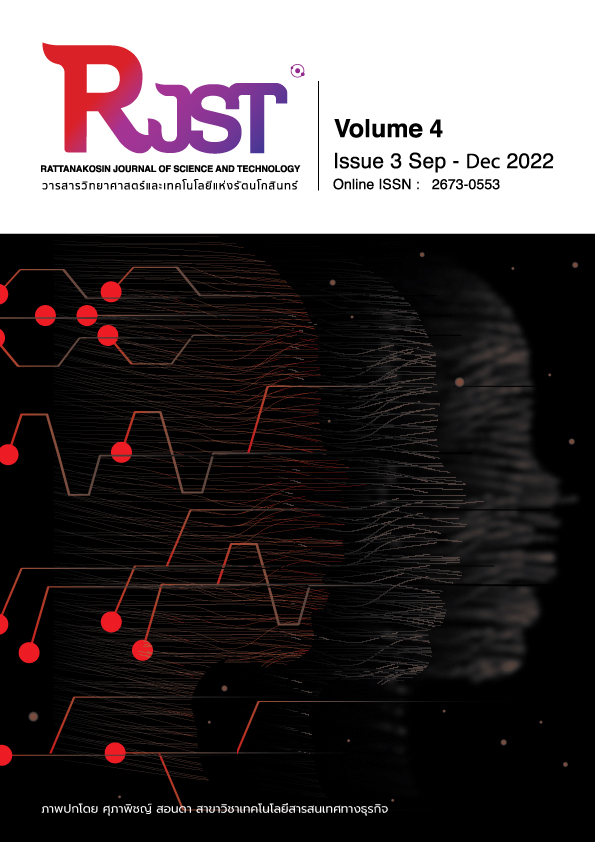สองสมการไดโอแฟนไทน์ 16^x+qp^y=z^4 และ 16^x-qp^y=z^4
Main Article Content
บทคัดย่อ
ในงานวิจัยนี้ได้แสดงว่าสองสมการไดโอแฟนไทน์ และ
เมื่อ
และ
เป็นจำนวนเฉพาะ โดยที่
และ
ไม่มีผลเฉลยที่เป็นจำนวนเต็มบวก
Article Details

อนุญาตภายใต้เงื่อนไข Creative Commons Attribution-NonCommercial-NoDerivatives 4.0 International License.
ข้อความภายในบทความที่ตีพิมพ์ในวารสารทั้งหมด รวมถึงรูปภาพประกอบ ตาราง เป็นลิขสิทธิ์ของมหาวิทยาลัยเทคโนโลยีราชมงคลรัตนโกสินทร์ การนำเนื้อหา ข้อความหรือข้อคิดเห็น รูปภาพ ตาราง ของบทความไปจัดพิมพ์เผยแพร่ในรูปแบบต่าง ๆ เพื่อใช้ประโยชน์ในเชิงพาณิชย์ ต้องได้รับอนุญาตจากกองบรรณาธิการวารสารอย่างเป็นลายลักษณ์อักษร
มหาวิทยาลัยฯ อนุญาตให้สามารถนำไฟล์บทความไปใช้ประโยชน์และเผยแพร่ต่อได้ โดยต้องแสดงที่มาจากวารสารและไม่ใช้เพื่อการค้า
ข้อความที่ปรากฏในบทความในวารสารเป็นความคิดเห็นส่วนตัวของผู้เขียนแต่ละท่านไม่เกี่ยวข้องกับราชวิทยาลัยจุฬาภรณ์ และบุคลากร คณาจารย์ท่านอื่น ๆ ในมหาวิทยาลัยฯแต่อย่างใด ความรับผิดชอบองค์ประกอบทั้งหมดของบทความแต่ละเรื่องเป็นของผู้เขียนแต่ละท่าน หากมีความผิดพลาดใด ๆ ผู้เขียนแต่ละท่านจะรับผิดชอบบทความของตนเอง ตลอดจนความรับผิดชอบด้านเนื้อหาและการตรวจร่างบทความเป็นของผู้เขียน ไม่เกี่ยวข้องกับกองบรรณาธิการ
เอกสารอ้างอิง
Klaška, J. (2017). Real-world applications of number theory. South Bohemia Mathematical Letters, 25(1), 39-47.
Kaur, D. & Sambhor, M. (2017). Diophantine equations and its applications in real life. International Journal of Mathematics and its Applications, 5(2B), 217-222.
Anbuselvi, R. & Sivasankari, J. (2019). Applications of Diophantine equations in chemical equations. Journal of Emerging Technologies and Innovative Research, 6(6), 371-373.
Dhurga, C.K. (2021). A linear Diophantine equation and its real life applications. Advances and Applications in Mathematical Sciences, 20(8), 1389-1394.
Chotchaisthit, S. (2012). On the Diophantine equation 4^x+p^y=z^2 where p is a prime number. American Journal of Mathematics and Sciences, 1(1), 191-193.
Chotchaisthit, S. & Worawiset, S. (2015). On the Diophantine equation 323^x+323^2s n^y =z^2t where s,t,n are non-negative integers and n≡5(mod 20). International Journal of Pure and Applied Mathematics, 100(3), 435-442. http://dx.doi.org/10.12732/
ijpam.v100i3.11
Chotchaisthit, S. & Worawiset, S. (2015). On the Diophantine equation 143^x+143^2s n^y =z^2t where s,t,n are non-negative integers and n≡5(mod 20). International Journal of Pure and Applied Mathematics, 100(3), 405-412. http://dx.doi.org/10.12732/
ijpam.v100i3.7
Chotchaisthit, S. & Worawiset, S. (2015). On the Diophantine equation 483^x+483^2s n^y =z^2t where s,t,n are non-negative integers and n≡5(mod 20). International Journal of Pure and Applied Mathematics, 100(4), 461-468. http://dx.doi.org/10.12732/
ijpam.v100i4.4
Rabago, J.F.T. (2018). On the Diophantine equation 4^x-p^y=3z^2 where p is a prime. hai Journal of Mathematics, 16(3), 643-650.
Laipaporn, K., Wananiyakul, S. & Khachorncharoenkul, P. (2019). On the Diophantine equation〖 3〗^x+p5^y=z^2. Walailak Journal of Science and Technology, 16(9), 647-653.
Elshahed, A. & Kamarulhaili, H. (2020). On the Diophantine equation〖 (4^n )〗^x-p^y=z^2. WSEAS Transactions on Mathematics, 19, 349-352.
Mihailescu, P. (2004). Primary cyclotomic units and a proof of Catalan’s conjecture. Journal für die Reine und Angewante Mathematik, 572, 167-195.


